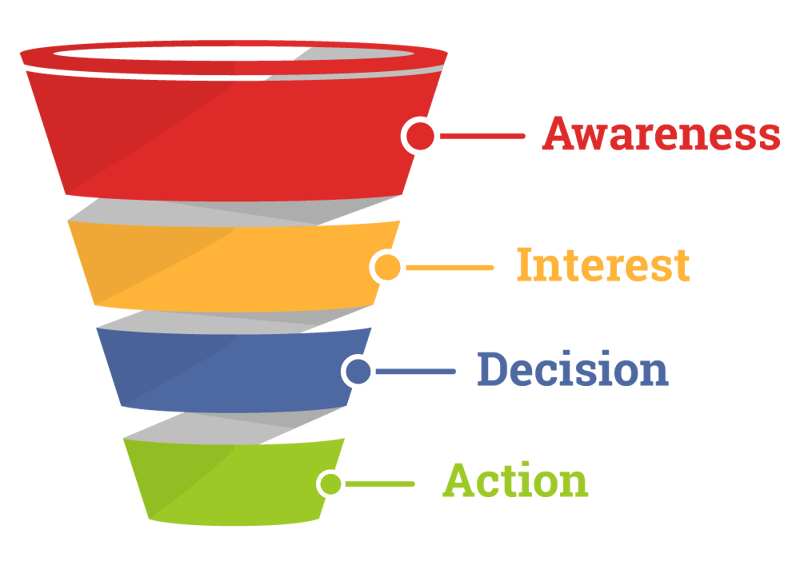
A Guide to Funnel Optimization [Definition, Tools & Strategies]
 Updated on
Updated on
 By Carlos Correa
By Carlos Correa
Carlos Correa
Carlos has been involved in the sales space for well over ten years. He began in the insurance space as an individual sales agent, managing teams as s...
learn more
Carlos Correa
Carlos has been involved in the sales space for well over ten years. He began in the insurance space as an individual sales agent, managing teams as s...
Table of Contents
Table of Contents
The truth is, making sales takes real work. There is so much competition that it is sometimes impossible for customers even to decide which product is the best for them.
This is where funnel optimization comes in, ensuring you're maximizing your opportunity for conversion at each stage of the sales funnel.
Funnel optimization is the process of improving (i.e., optimizing) interactions with customers at each stage of the sales funnel. It refers to your company's actions to fine-tune your processes to produce the highest acquisition, conversion, and retention of prospective customers.
Let's illustrate.
Buying a car is not a straightforward process; it has over twenty-five different touchpoints before a consumer decides on the model and trim level they want.
At every stage, there is messaging talking about car options, and each of these messages might push the customer toward a completely different decision. And from there, the consumer makes a decision.
The right message at the right time might cause the customer to make a quick decision they might not have made before.
We call this process the buyer's journey, which we simplify into a sales funnel, which illustrates that at each stage, customers drop out.
The buyer's journey is then simplified into the sales and marketing funnel, which looks something like this:

The sales funnel process follows prospective customers from their first interaction with your business until they become a customer and even beyond. Most funnels will include awareness, consideration, and conversion, although there are more straightforward and more complex versions of this idea.
Sales funnel optimization is essential for businesses that want to make the most of their resources. Optimization helps you find areas in your sales department and company that could use improvement and make them run like clockwork. This process uses key funnel optimization strategies to catch a potential customer's interest and bring them in for sale.
|
Sales funnel optimization is… |
Sales funnel optimization is NOT… |
|
Fine-tuning sales and marketing techniques |
It is not usually an overhaul of strategy |
|
Tweaks based on customer research or testing |
Changes that are not made for target consumers |
|
Always data-driven |
Randomly changing strategies for the sake of trying something new |
|
Flexible, agile, and evolving |
Rigid and stiff |
|
Customizable |
One-size fits all |
Sales Funnel Optimization vs. Sales Conversion Strategy
Let's clarify two terms that often get thrown around interchangeably—sales funnel optimization and sales conversion strategy. While they share the same ultimate goal (turning leads into paying customers), they approach the journey very differently.
Think of funnel optimization as the full-course meal and conversion strategy as the seasoning, it's all about scope and focus.
Here's a breakdown of what sets them apart:
|
Aspect |
Sales Funnel Optimization |
Sales Conversion |
|
Scope |
Full funnel—from first touch to retention |
Narrow focus—usually bottom-funnel touchpoints |
|
Goal |
Improve flow, reduce friction, and guide leads seamlessly |
Increase conversion rates at critical moments |
|
Examples |
Examples include enhancing landing pages, email nurturing, retargeting, and multi-channel alignment |
Examples include A/B testing CTA buttons, optimizing checkout UX, and tweaking pricing display |
|
Tools Used |
Funnel optimization tools like ClickFunnels, Hotjar, HubSpot, Google Optimize |
Conversion rate optimization (CRO) tools like Optimizely, Unbounce, VWO |
|
KPIs |
Funnel drop-off rates, time to conversion, customer lifetime value (CLV) |
Click-through rate (CTR), form completion rate, cart abandonment rate |
|
Best For |
Brands needing a holistic sales funnel optimization strategy |
Teams focused on plugging conversion leaks in high-traffic areas |
Okay, so now you know what sales funnel optimization is.
But doesn't that sound kind of similar to a sales conversion strategy?
The two are related, but the difference lies in your team's objectives and scope of action. A sales conversion strategy is laser-focused on the final push—getting the deal closed. It deals with immediate, bottom-funnel actions like optimizing CTA buttons, streamlining checkout flows, or even adding a personal touch with a photo in a rep's email signature.
On the flip side, funnel optimization looks at the entire sales journey and fine-tunes each stage, including awareness, interest, decision, and conversion. From generating qualified leads at the top through marketing to removing bottlenecks at the decision stage, it's a full-funnel process.
For example:
- Awareness: Creating engaging content or running targeted ads
- Interest: Scoring leads and qualifying them
- Decision: Addressing objections and offering tailored solutions
- Conversion: Closing the sale, often with a sales assist or final incentive
This approach requires collaboration between sales and marketing, especially since marketers often drive awareness and interest, while sales takes over during the decision and conversion stages.
Meanwhile, sales conversion optimization focuses more on the salesperson's tactics, including A/B testing copy, optimizing timing, or adjusting tone. These subtle changes can massively influence buyer decisions.
Funnel optimization strategies and sales conversion strategies aren't competitors, but teammates. When aligned properly, they power full funnel optimization and lead to more conversions, better customer retention, and ultimately, more revenue.
Sales Funnel Optimization for eCommerce

As you may already know, eCommerce is a battlefield. You've fought hard to drive traffic, nurtured leads through targeted ads, and gotten someone to click "Add to Cart." But just as you're about to win the war... they bail.
That's where sales funnel optimization for eCommerce steps in. It's all about reducing friction, nudging customers toward the finish line, and making sure your store is a conversion machine.
Here's how funnel optimization strategies can transform your eCommerce sales funnel from leaky to legendary:
1. Reducing Cart Abandonment
Cart abandonment is the arch-nemesis of every online store. According to a 2023 Baymard Institute study, the average cart abandonment rate sits at 70.19%. Ouch. Why? Shipping surprises, complex checkout processes, and security concerns top the list.
Optimizing this stage of your funnel means minimizing unpleasant surprises. Display shipping costs early, offer guest checkout, and keep the path to purchase clean and simple. You can also deploy smart retargeting, triggered emails or ads that bring back window shoppers. These are all classic sales funnel optimization strategies tailored to eCommerce pain points.
2. Simplifying Checkout
Your checkout process shouldn't feel like a tax form. The longer and clunkier it is, the more likely you are to lose the sale. Sales funnel optimization here means reducing steps, enabling auto-fill, and cutting unnecessary fields. Even something as simple as combining name fields or defaulting the shipping address to billing can shave precious seconds off the process.
And if you're not offering express checkout options like Apple Pay, Google Pay, or Shop Pay, you're already behind. Shoppers want fast, frictionless checkouts, and that's where a good funnel optimization tool can show you exactly where users drop off.
3. Personalizing Product Recommendations
Personalization isn't just a nice touch, it's a powerful sales conversion strategy. When shoppers feel like your store "gets them," they're more likely to convert. Whether it's AI-driven upsells, dynamic recommendations, or targeted bundles, personalization increases average order value and reduces decision fatigue.
Think of it as micro-level funnel optimization: you're influencing buyer behavior by presenting the right product at the right moment.
And it works! According to recent findings, 96% of consumers are more likely to purchase when brands offer personalized messaging. Enough said.
Top Sales Funnel Optimization Tools
No matter how brilliant your strategy is, you can't optimize what you can't measure, or automate. That's why choosing the right funnel optimization tool is just as important as building the funnel itself.
Whether you're nurturing leads, split-testing your landing pages, or recovering abandoned carts, there's a tool out there built to boost your conversion game.
Below is a breakdown of top sales funnel optimization tools categorized by function. Together, they'll help you monitor, analyze, and fine-tune every part of your funnel, from awareness to conversion and beyond.
|
Tool |
Purpose |
Key Features |
|
CRM tools like Ringy |
Lead tracking, follow-ups, automation |
Built-in VoIP, email + SMS automation, sales funnel tracking, and full integration with marketing tools |
|
A/B testing platforms (e.g., Optimizely) |
Test funnel elements |
Multivariate testing, audience targeting, real-time results, no-code visual editor |
|
Analytics tools (e.g., Google Analytics, Hotjar) |
Funnel performance tracking or identify funnel bottlenecks |
Behavior flow analysis, custom goals, conversion tracking, GA4 funnel exploration, Heatmaps, session recordings, feedback widgets, user journey insights |
|
Cart recovery tools (e.g., Rejoiner |
Re-engage abandoners |
Triggered email campaigns, personalized recovery flows, segmentation, performance analytics |
Each of these tools plays a specific role in full funnel optimization. Together, these tools support a data-backed, insight-driven funnel optimization strategy, so you can stop guessing and start converting with confidence.
7 Sales Funnel Optimization Strategies

You've got the tools. You've got the traffic. But if leads are slipping through the cracks, it's time to put strategy into action. Whether you're running a lean startup or scaling an eCommerce empire, the right sales funnel optimization strategies can transform your pipeline from a leaky bucket into a customer-generating machine.
Here are seven tried-and-true tactics to sharpen your funnel optimization game from top to bottom:
1. Map and Analyze Your Existing Funnel Stages
You can't fix what you can't see. Start by mapping your current funnel by asking yourself the following:
- What channels are bringing people in?
- Where are they dropping off?
- What stages feel like a black hole?
Use analytics tools (like Google Analytics or Hotjar) to visualize behavior flows, spot funnel bottlenecks, and prioritize improvements.
This is also where funnel analysis product management techniques come in handy: tracking drop-offs, conversion lag, and bounce rates helps diagnose exactly where attention (or friction) lives in your funnel.
2. Create Targeted, Personalized Content for Each Stage
One-size-fits-all content is a conversion killer. Instead, develop content that speaks directly to each stage of the funnel. Blog posts and social ads for awareness, case studies and comparison guides for decision-making, and testimonials or discounts for conversion.
Personalization fuels sales funnel optimization. Whether it's a custom email or dynamic on-site messaging, this strategy builds trust and nudges leads forward.
3. Simplify Your CTAs and Forms
Ever seen a "Download the 7-Step Industry-Compliant PDF Checklist Here" button? Yikes. Your sales conversion strategy should focus on clarity and brevity. Use short, action-oriented CTAs and eliminate form fields you don't absolutely need. The less friction, the more conversions.
Want more signups or quote requests? Cut that five-step form in half. Funnel optimization meaning = fewer clicks, more results.
4. Use Automation for Timely Follow-Ups
Time kills deals, especially when leads go cold. CRM platforms like Ringy can automate your follow-ups with timely emails, SMS, and even voicemail drops based on user behavior. This keeps prospects engaged while saving your team hours.
Sales funnel optimization tools with automation features ensure no lead gets left behind, especially in complex B2B funnels where nurturing matters just as much as the close.
5. Implement Retargeting Campaigns
Most people don't convert the first time they visit your site. Retargeting campaigns bring them back with personalized ads that reinforce your offer, address objections, or showcase popular products.
This is crucial for sales funnel optimization ecommerce strategies. From Meta Pixel to Google Ads retargeting, these tactics boost conversion rates by up to 150%.
6. Test and Refine Funnel Elements (A/B Testing)
Your gut is great, but data is better. Use A/B testing platforms like Optimizely or Unbounce to test different headlines, layouts, CTA placements, and more. Even a small change, like button color or copy, can improve conversion rates dramatically.
This hands-on approach to funnel optimization strategies ensures you're always iterating based on real user behavior, not guesswork.
7. Align Sales and Marketing Teams on Funnel Goals
Here's the kicker: your funnel is only as strong as the team managing it. If sales and marketing are out of sync, your leads will feel it. Get both teams aligned on shared KPIs, ideal customer profiles, and lead qualification criteria.
This cross-functional clarity is the backbone of full funnel optimization. Sales can give feedback on lead quality, while marketing adjusts the content and campaigns to close the loop.
Remember, sales funnel optimization isn't a one-and-done fix. It's an ongoing process of refinement and alignment. But with the right strategy, tools, and teamwork, your funnel can go from average to unstoppable.
Conclusion
It's pretty clear by now that in order for a business to reach its fullest potential, they need to be employing sales funnel optimization.
Without an idea of how each stage of the customer's journey works, businesses might as well be in the dark. Sales funnel optimization allows you to make every choice for your business based on data and forecasting, not random guesses.
And with a CRM company like Ringy to back you up, there's no way you can go wrong. So contact Ringy today and schedule your free demo and see how funnel optimization can help your company achieve its goals.

Skyrocket your sales with the CRM that does it all.
Calling? Check. SMS? Check. Automation and AI? Check. Effortlessly keep in touch with your customers and boost your revenue without limits.

Take your sales to new heights with Ringy.
Sales in a slump? Ringy gives you the tools and flexibility you need to capture leads, engage with them, and turn them into customers.
Subscribe to Our Blog
Enter your email to get the latest updates sent straight to your inbox!
Categories
Related Articles



































































































